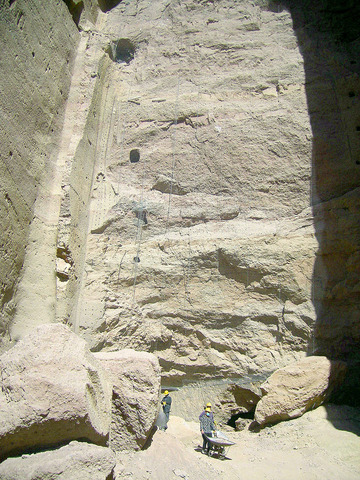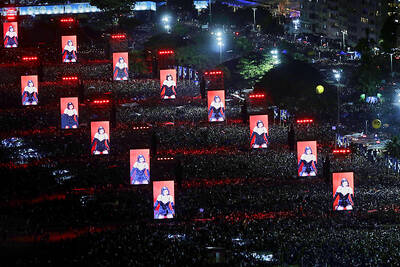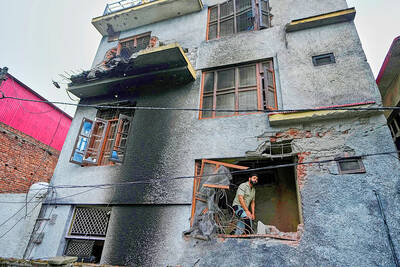Like all Shiites, Afghanistan's Hazaras are waiting for the reappearance of the Mahdi, but those in the Bamiyan Valley are also hoping for the return of the ancient giant Buddhas torn down in 2001 by the Taliban government in a fit of iconoclastic rage.
At the foot of a cliff where the niches once inhabited by the statues are testimony to their once-towering grandeur, international teams gathered by the UN to repair the Buddhist relics are preparing to break camp for winter.
Where the larger Buddha once stood at 55m, workers under German supervision collect fragments, while an Italian team is at the site not far away of the 38m Buddha considered to have a more feminine face.

PHOTO: AFP
Between these two teams, Japanese experts are working on preserving what is left of murals adorning the walls of a network of caves, while Italian mountaineers are suspended from ropes slung over the smaller Buddha as they plug faults in the rock, embed steel anchors and install movement sensors.
"Bombs have created many fissures and it's very dangerous because it's very unstable," Italian engineer Gedeone Tonoli said.
The task was begun two years ago and is due to be completed before the year's work wraps up on Nov. 15, he said.
"After that temperatures fall below zero Celsius and we have problems with the machines," he said.
Because of the size and density of the statues, their destroyers deployed an enormous amount of explosives, some of which failed to detonate at the time and now present a daily hazard -- along with landmines left over from decades of war -- for the repair teams.
"Unfortunately we discover a lot of unexploded devices," said German architect Georgios Toubekis from the International Council on Monuments and Sites.
"Just recently we had two bombs of 250kg. One of them had to be exploded behind this field -- it took one week to pull it out carefully because it was heavily damaged. The other one luckily was more easy to take away," he said.
Because of this danger, no heavy machinery is allowed inside the larger niche and everything is done by hand, Toubekis said.
"The progress was very slow this year because of all these bomb findings," he said, describing the work as still in an emergency phase.
In front of the caves, Japanese specialists take down their scaffolding and seal the caves to protect the paintings, 80 percent of which were destroyed during the war, from animals that may stray inside.
"We can't stay in the caves -- it's very freezing, very cold," Yoko Taniguchi said.
That the murals were created with water-soluble paint further complicates preservation work, she said, because they are so easily damaged by the weather.
Bamiyan, some 200km northwest of Kabul, stands in a deep green and lush valley stretching 100km through central Afghanistan, on the former Silk Road that once linked China with Central Asia and beyond. It was a center of Buddhist scholarship and worship between the second and ninth centuries, before the coming of Islam.
In February 2001 Mullah Omar, head of the Taliban government then ruling Afghanistan, ordered the destruction of the Buddhas as idolatrous symbols.
The order for the destruction of the massive sandstone structures -- until then the largest standing Buddhist statues in the world -- led to an international outcry and calls for them to be spared for their historical significance if nothing else. But in vain.
Now, the people of Bamiyan are firm in their belief that the Buddhas must be restored to raise the status of the valley and attract tourists -- and income.
"If it is not possible for both of them, at least one of them can be rebuilt," provincial governor Habiba Surobi said.
But the international experts say the local people would be naive to expect the relics to ever be returned to their original state.
"Everybody is asking when the Buddhas will be reconstructed," Toubekis said, but adds: "At this moment there is no decision it is going towards this direction."
The main reason, he said, is that the statues are "much more fragmented than everybody thought. Nobody at the moment is behind putting it together like a puzzle, because I think it is not possible."
There is however the possibility of employing the archeological process of anastylosis by which ruined monuments are reassembled from old fragments and, when necessary, new materials.
But Toubekis believes that if the Bamiyan Buddhas were rebuilt in this manner they could lose their world heritage status and their value as tourism drawcards could be diminished.

A new online voting system aimed at boosting turnout among the Philippines’ millions of overseas workers ahead of Monday’s mid-term elections has been marked by confusion and fears of disenfranchisement. Thousands of overseas Filipino workers have already cast their ballots in the race dominated by a bitter feud between President Ferdinand Marcos Jr and his impeached vice president, Sara Duterte. While official turnout figures are not yet publicly available, data from the Philippine Commission on Elections (COMELEC) showed that at least 134,000 of the 1.22 million registered overseas voters have signed up for the new online system, which opened on April 13. However,

ENTERTAINMENT: Rio officials have a history of organizing massive concerts on Copacabana Beach, with Madonna’s show drawing about 1.6 million fans last year Lady Gaga on Saturday night gave a free concert in front of 2 million fans who poured onto Copacabana Beach in Rio de Janeiro for the biggest show of her career. “Tonight, we’re making history... Thank you for making history with me,” Lady Gaga told a screaming crowd. The Mother Monster, as she is known, started the show at about 10:10pm local time with her 2011 song Bloody Mary. Cries of joy rose from the tightly packed fans who sang and danced shoulder-to-shoulder on the vast stretch of sand. Concert organizers said 2.1 million people attended the show. Lady Gaga

CONFLICTING REPORTS: Beijing said it was ‘not familiar with the matter’ when asked if Chinese jets were used in the conflict, after Pakistan’s foreign minister said they were The Pakistan Army yesterday said it shot down 25 Indian drones, a day after the worst violence between the nuclear-armed rivals in two decades. Pakistani Prime Minister Shehbaz Sharif vowed to retaliate after India launched deadly missile strikes on Wednesday morning, escalating days of gunfire along their border. At least 45 deaths were reported from both sides following Wednesday’s violence, including children. Pakistan’s military said in a statement yesterday that it had “so far shot down 25 Israeli-made Harop drones” at multiple location across the country. “Last night, India showed another act of aggression by sending drones to multiple locations,” Pakistan military spokesman Ahmed

SUPPORT: The Australian prime minister promised to back Kyiv against Russia’s invasion, saying: ‘That’s my government’s position. It was yesterday. It still is’ Left-leaning Australian Prime Minister Anthony Albanese yesterday basked in his landslide election win, promising a “disciplined, orderly” government to confront cost-of-living pain and tariff turmoil. People clapped as the 62-year-old and his fiancee, Jodie Haydon, who visited his old inner Sydney haunt, Cafe Italia, surrounded by a crowd of jostling photographers and journalists. Albanese’s Labor Party is on course to win at least 83 seats in the 150-member parliament, partial results showed. Opposition leader Peter Dutton’s conservative Liberal-National coalition had just 38 seats, and other parties 12. Another 17 seats were still in doubt. “We will be a disciplined, orderly